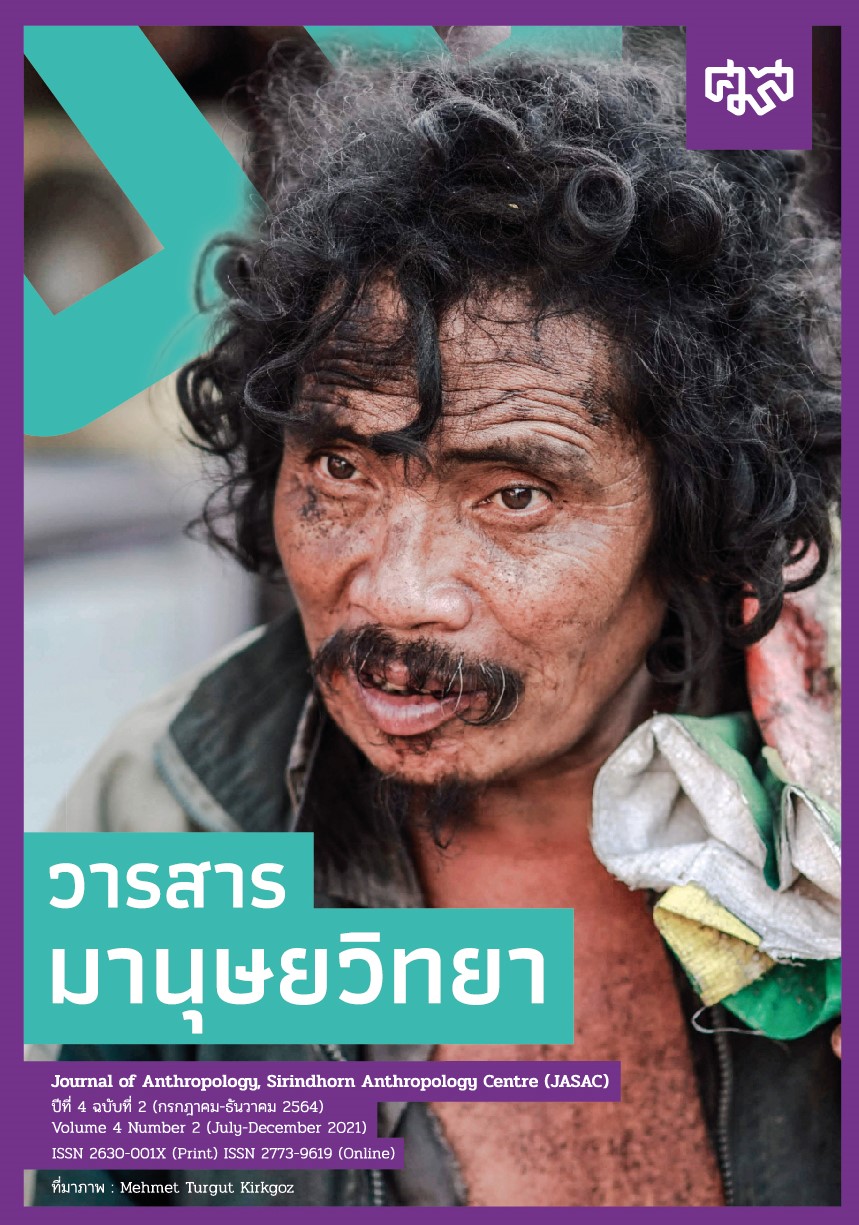ชาวโอรังอัสลี กลุ่มจาไฮ จังหวัดยะลา-นราธิวาส การวิจัยสำรวจภาคสนามเบื้องต้น
Main Article Content
บทคัดย่อ
บทความวิจัยนี้นำเสนอกลุ่มชนโอรังอัสลี กลุ่มย่อยจาไฮ (the Jahai) เกี่ยวกับข้อมูลพื้นฐานที่สำคัญได้แก่จำนวนประชากร มีทั้งหมด 439 คน มีภูมิศาสตร์ถิ่นที่อยู่อาศัยที่จังหวัดยะลาและนราธิวาส ในเขตรักษาพันธุ์สัตว์ป่าฮาลา-บาลา และอุทยานแห่งชาติบางลางซึ่งเชื่อมต่อกับป่าเบอลม (Belum) ประเทศมาเลเซีย มีการจัดกลุ่มองค์กรทางสังคม (social organization) เป็นแบบกลุ่มเครือญาติ (band) ชาวจาไฮไม่มีภาษาเขียนแต่มีศิลปะลวดลายอยู่ในอาวุธและของขวัญ (gift) ที่ผู้ชายทำให้แก่ภรรยา โครงสร้างองค์กรประกอบด้วยครอบครัวและเครือญาติ ผู้ชายเป็นหัวหน้าครอบครัว ผู้หญิงคือผู้จัดการ ผู้สูงอายุทั้งชายและหญิงเป็นผู้มีอำนาจสูงสุดสามารถติดต่อกับบรรพบุรุษที่อยู่ในโลกต่างมิติได้ ให้คำปรึกษาและข้อแนะนำแก่ผู้นำกลุ่ม สังคมจาไฮไม่มีชนชั้น จัดช่วงชั้นตามวัยของสมาชิก ชาวจาไฮมีความสัมพันธ์กับคนภายนอกที่อยู่ในที่ราบ คือ ชาวมลายูมุสลิมและชาวไทยพุทธ ในลักษณะต่างพึ่งพากันและกัน แต่โดยส่วนใหญ่ไม่มีบัตรประชาชน ไม่มีความรู้ทางด้านกฎหมายแต่มีความจำเป็นในเรื่องอาหาร เช่น ข้าว ซึ่งนำมาทดแทนหัวมันในป่าที่กำลังขาดแคลน จึงกลายเป็นเบี้ยล่างทางเศรษฐกิจถูกกดขี่ค่าจ้างแรงงานจากปัญหาการทำลายพื้นที่ป่าบริเวณกว้างจากเขื่อนบางลางทำให้พวกเขาต้องปรับโครงสร้างขององค์กร มีการรวมเป็นกลุ่มใหญ่อยู่บนที่สูงประมาณ 800 เมตรจากระดับน้ำทะเล และแตกเป็นกลุ่มย่อย 7-15 คนเพื่อรับจ้างและนำข้าวกลับไปสนับสนุนการยังชีพในกลุ่มใหญ่หลายกลุ่ม ชาวจาไฮมีศาสนา นับถือบรรพบุรุษที่คล้ายพระเจ้าผู้ให้กำเนิด และมีความเชื่อหลังความตายว่าผู้ตายจะพลิกไปอยู่มิติคู่ขนาน ซึ่งเหมือนกันกับโลกปัจจุบันแต่มีความอุดมสมบูรณ์ไม่เสื่อมตามโลกปัจจุบัน และบรรพบุรุษสามารถพลิกเอาความสมบูรณ์ของธรรมชาติโลกจากคู่ขนานมาฟื้นสภาพป่าโลกปัจจุบันได้ สถานการณ์ชาวจาไฮอยู่ในระดับวิกฤติถูกฉวยใช้ประโยชน์จากบางคนและบางกลุ่ม และวิกฤติจากปัญหาโภชนาการ แต่อย่างไรก็ตามชาวจาไฮยังคงต้องการอาศัยอยู่ในที่แห่งนี้และในประเทศไทย เพราะต้องการความอิสระในการดำรงวิถีชีวิตแบบเร่ร่อน (nomadic) เพื่อล่าและเก็บหาของป่า (hunter and gatherers) ได้เช่นเดิม ซึ่งแตกต่างจากประเทศมาเลเซียที่ต้องปรับตัวอยู่อาศัยในหมู่บ้านในพื้นที่ราบ
Article Details

อนุญาตภายใต้เงื่อนไข Creative Commons Attribution-NonCommercial-NoDerivatives 4.0 International License.
ลิขสิทธิ์@ของวารสารมานุษยวิทยา
ศูนย์มานุษยวิทยาสิรินธร (องค์การมหาชน), กรุงเทพฯ, ประเทศไทย
ข้อมูลเพิ่มเติม:
https://creativecommons.org/licenses/by-nc-nd/4.0/
เอกสารอ้างอิง
กิติยา ถาวโรฤทธิ์, สุขสุพันธ์ พงษ์พันธ์, และ แสงประดับ นฤมล. (2560). ความหลากหลายของแมลงชีปะขาว แมลงสโตนฟลาย และแมลงหนอนปลอกน้ำ ในเขตรักษาพันธุ์สัตว์ป่าฮาลา-บาลา จังหวัดนราธิวาส. วารสารมหาวิทยาลัยนราธิวาสราชนครินทร์, 9(3), 149-161.
บุญเสริม ฤทธาภิรมย์, และ ณ น่าน สมฤทัย. (2548). ไม่มีเงาะซาไกในประเทศไทย. กรุงเทพฯ: ภาพพิมพ์.
บุญเสริม ฤทธาภิรมย์, และ ณ น่าน สมฤทัย. (2557). เราควรเรียกเงาะป่าในภาคใต้ของไทยว่าเงาะซาไกหรือ. วารสารรามคำแหง ฉบับมนุษยศาสตร์, 33(1), 71-88.
เยาวลักษณ์, วิลัย. (2538). ลักษณะแฮปโพลไทป์ของยีนบีตาอี-โกลบินในชนเผ่าซาไกและชาวชอง. (ปริญญาโท). พันธุ์ศาสตร์ วิทยาศาสตรมหาบัณฑิต จุฬาลงกรณ์มหาวิทยาลัย, กรุงเทพฯ.
วิกิพีเดีย. (2561). เขตรักษาพันธุ์สัตว์ป่าฮาลา-บาลา. Retrieved from https://th.wikipedia.org/wiki/เขตรักษาพันธุ์สัตว์ป่าฮาลา-บาลา
กรมอุทยานแห่งชาติสัตว์ป่าและพันธุ์พืช สำนักงานอนุรักษ์สัตว์ป่า. (2549). สถานีวิจัยสัตว์ป่าป่าพรุ ป่าฮาลา-บาลา. Retrieved from http://web3.dnp.go.th/wildlifenew/animConserveDepView.aspx?depId=59
สำนักอุทยานแห่งชาติ, ก. ท. ง. ส. ต. ป. า. น. พ. ช. (2562). บางลาง (Bang Lang). Retrieved from http://park.dnp.go.th/visitor/nationparkshow.php?PTA_CODE=1089
Andaya, L. Y. (2008). Leaves of the Same Tree : Trade and Ethnicity in the Straits of Melaka. Honolulu: University of Hawaii Press.
Charles, H. (2013). Hunter-Gatherers in Southeast Asia: From Prehistory to the Present. (1), 21. Retrieved from http://search.ebscohost.com/login.aspx?direct=true&db=edspmu&AN=edspmu.S1534661713100100&site=eds-live&authtype=ip,uid
Dentan, R. K. (1997). The persistence of received truth: how the Malaysian ruling class constructs Orang Asli. In W. R.L. (Ed.), Indigenous Peoples and the State: Politics, Land, and Ethnicity in the Malayan Peninsula and Borneo. Yale University Southeast Asia Studies, Monograph Series, No. 46, Yale University Southeast Asian Studies (pp. 98–134). Connecticut: New Haven.
Dentan, R. K., Endicott, K., Gomes, A. G., & Hooker, M. B. (1997). Malaysia and the "original people": a case study of the impact of development on indigenous peoples. Boston: Allyn and Bacon.
Evans, I. H. N. (1929). Review - Among the Forest Dwarfs of Malaya. Journal of the Malayan Branch of the Royal Asiatic Society, 7(3), 470-472.
Kutanan, W., Kampuansai, J., Changmai, P., Flegontov, P., Schröder, R., Macholdt, E., . . . Stoneking, M. (2018). Contrasting maternal and paternal genetic variation of hunter-gatherer groups in Thailand. Scientific Reports, 8(1), 1536. doi:10.1038/s41598-018-20020-0
Nagata, S. (2006). Subgroup 'names' of the Sakai (Thailand) and the Semang (Malaysia): a literature survey. Anthropological Science, 114(1), 45-57. doi:10.1537/ase.00082


